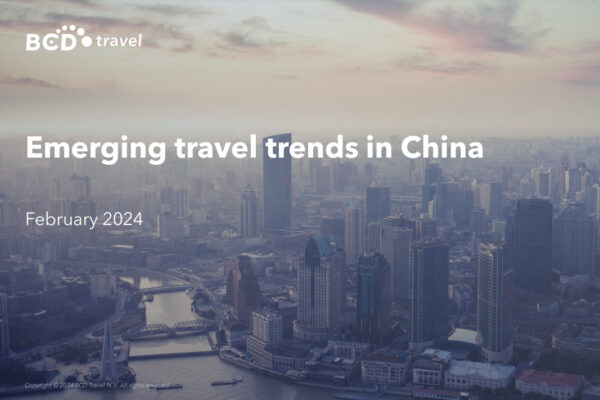Introduction
As we enter 2024, and just over a year after its reopening and the ending of COVID-19 restrictions, China’s economy is still trying to fully shake off the after-effects of the pandemic. Commercial activity is on a path to normalcy, and corporate travel has a vital role to play. Its return is not merely a function of the recovery in business activity; corporate travel is also a catalyst for commerce and the development of enhanced interconnectivity between enterprises. In a country characterized by rapid advances in technology and transportation, corporate travel embodies China’s wider business ethos, taking a position at the forefront of emerging business trends.
In his recent LinkedIn article , “The Business of Mobility: Emerging Trends in China’s Corporate Travel for 2024,” BCD Travel’s Managing Director North Asia, Jonathan Kao, examined the emerging trends that he believes are reshaping corporate travel in China. While each trend has its own distinct characteristics, together these trends form a cohesive blueprint for the future of business mobility in China.
In this new report, with Jonathan’s support and including some invaluable local insights from William Tang, we’ve expanded upon the original article to give the trends some greater context and include some extra information to support them. The report covers the following trends and developments:
- China’s travel recovery – the outlook for air travel and the return of airline capacity.
- China’s economic slowdown and corporate travel – how travel managers are responding to China’s economic underperformance.
- Changing the way employees work and travel – the shift to virtual meetings and the appeal of bleisure travel.
- Data-driven travel management – how data analytics are enhancing efficiency and cost effectiveness.
- The government’s anti-corruption drive – how this has affected life sciences companies, in particular.
- Reducing risks for travelers and their personal data – developments in risk management and safeguarding employees’ personal information.
- Sustainable travel – how China is embracing eco-friendly practices, including the shift to high-speed rail for domestic business trips.

Jonathan Kao
Managing Director, North Asia

William Tang
Senior Director, Operations – Greater China

Mike Eggleton
Director, Research & Intelligence
China’s travel recovery
International travel slow to recover
Airline traffic (revenue passenger kilometers – RPKs) in the Chinese market suffered a deep and prolonged downturn during the COVID-19 pandemic.
Data from the International Air Transport Association (IATA) shows domestic traffic finally recovering above 2019 levels in 2023.1 The prospects for domestic air travel seem encouraging: By 2025, IATA expects airline traffic to be onethird higher than in 2019.
The picture is quite different for international travel. Traffic was far more severely impacted by the pandemic, and it has been much slower to recover. IATA does not currently forecast a full recovery until 2025, but international traffic could then move 11% higher than its pre-pandemic level.
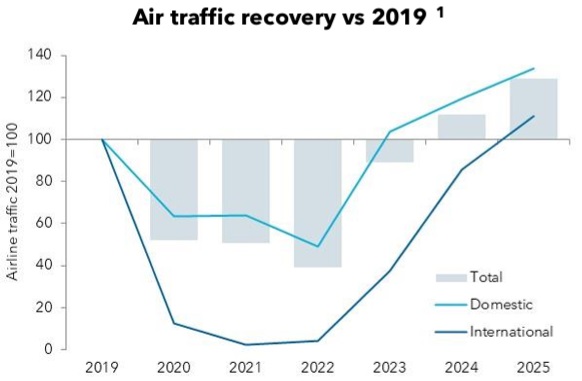
The recovery in the domestic segment has shown that the appetite for air travel clearly exists. Airlines have responded by offering 16% more seats than before the start of the pandemic.2 It’s possible that airline capacity could be a key factor holding back the return of international demand. In January 2024, international airline seats available in the Chinese market were still 33% below 2020 levels. The shortfall was even deeper in South and Southeast Asian markets, and capacity to North America is at less than 20% of its pre-pandemic level. But airlines are restoring international services, and more will be reinstated in the summer 2024 schedule.
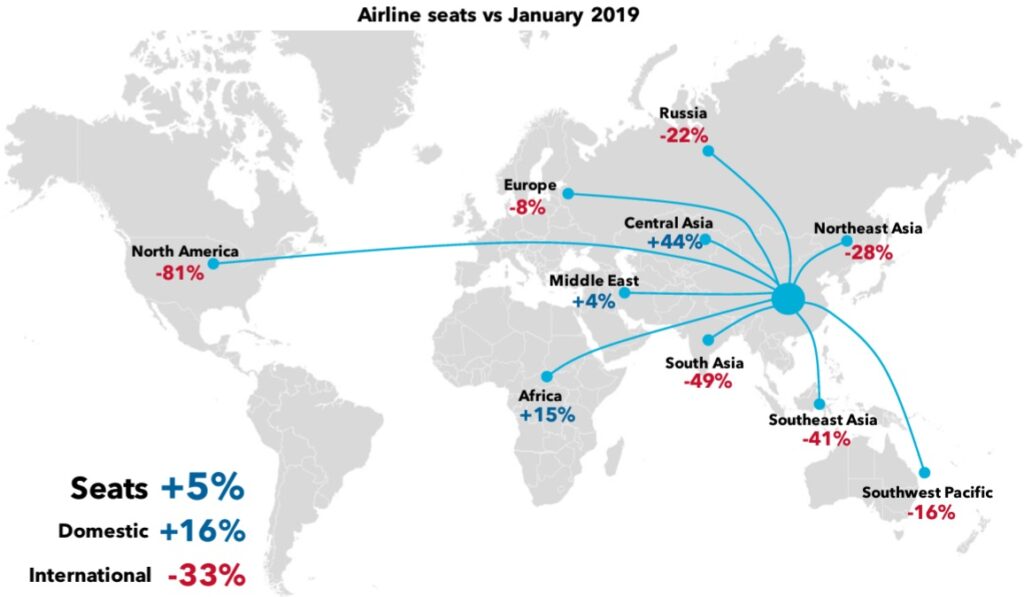
China’s economic slowdown will impact corporate travel
Economic underperformance likely to continue
The much-anticipated surge in economic activity failed to appear following China’s ending of COVID-19 restrictions from the end of 2022. As it entered 2023, China’s economy had to contend with some fierce headwinds, including soaring youth unemployment, a real estate crisis and the effects of a steep rise in the cost of living in western markets on their demand for Chinese exports.
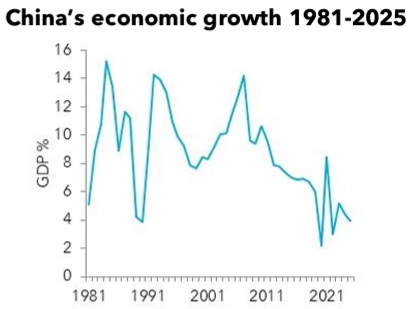
According to Oxford Economics, economic growth is likely to come in at 5.2% in 2023 – China’s weakest performance (excluding the pandemic period) since 1990’s 3.9% expansion in GDP (gross domestic product). Oxford Economics predicts weaker growth still of 4.4% in 2024. Absent will be the brief boost China’s economy enjoyed last year, as consumer demand picked up following the lifting of COVID-19 restrictions. And growth may even dip below 4% in 2025.
By historic standards, near term growth will be weak. China’s economic prospects remain fragile. It already faces some long-term challenges, including an ageing population, a shrinking workforce and high levels of debt.3 Growing economic friction between China and the West is also unlikely to abate, particularly as governments in Europe and the U.S. respond to concerns about growing imports of lower-cost electric vehicles built in China. To restore its fortunes, China will need some bold new measures to bolster growth.
How travel managers will respond
With slower economic growth, as demand softens and profits come under pressure, companies will look to lower their costs. Corporate travel budgets will inevitably come under scrutiny. More than ever, travel managers will need to demonstrate their resourcefulness, if they are to successfully reduce costs whilst ensuring that business travel remains effective and supportive to company goals. Rather than indiscriminately cutting the number of trips taken by employees, Chinese companies may adopt a more sophisticated approach that seeks to maximize the returns from any investment in corporate travel. Travel managers can be expected to be more rigorous in establishing a trip’s return on investment (RoI).

One simple way to reduce costs would be to shift air travel to lower cost airlines. Or travel managers might encourage employees to combine business trips with some leisure time, fully leveraging the benefits (for both the company and employee) of each trip. This might seem a strange way of reducing travel costs, but it shows travel managers are looking for benefits beyond simple cost reduction. They recognize travel not just as an expense, but as an investment in employees, with productivity improvements a potential bonus (and extra source of cost savings) for the company.
Providing a quality travel experience for employees within a constrained budget has become an integral part of a travel manager’s role. Beyond some of the immediate cost reduction measures outlined above, travel managers are also thinking ahead, looking to ensure they can continue to keep costs contained. They’re investing in digital platforms to facilitate virtual meetings and sophisticated data analysis tools to help pinpoint opportunities for cost efficiencies. Chinese companies don’t simply think about today’s challenges; they embody a forward-thinking vision, which will put them in a strong position once China’s economic challenges fade.
Changing the way employees work and travel
Virtual meetings will shape business communication
The pandemic caused a seismic shift in the workplace, as travel bans and lockdowns dramatically changed how and where many employees worked. China’s companies were quick to adapt their business communications to this new environment. Once a novel concept, virtual meetings have now become a mainstay of China’s business operations. With the adoption of local platforms like Tencent Meeting and Alibaba’s DingTalk, and global offerings like Microsoft Teams and Zoom, virtual meeting and conferencing tools have become seamlessly integrated into daily work.

The swift transition to virtual engagement has yielded several benefits. It has curtailed the necessity for extensive travel, which was particularly helpful when airlines heavily scaled back their schedules during the pandemic. It has also reduced operational costs and ushered in unmatched flexibility in collaborative work, both within and across teams.
Far from being a mere stopgap measure in a time of crisis, virtual meetings are now widely recognized as a transformative force in shaping internal business communications and training protocols in China.
The widespread move to online meetings isn’t just about logistical convenience; it heralds a larger cultural transition towards digital adeptness and echoes Chinese companies’ commitment to sustainability by reducing travel volumes.
Bleisure travel
With China’s travel recovery now well under way, business travelers are increasingly embracing what has become known as bleisure travel – business trips that are extended to include some leisure time. The concept is already well-established outside of China. In a 2022 BCD Travel survey, 50% of (mainly North American) travelers revealed that they’d be likely to tag some leisure days on to a business trip.4 This trend is now gaining traction among Chinese employees, who aspire to a greater balance between work and recreation in their lives. They’re seeking an enriched life experience.
International air capacity in the Chinese market is still 40% below its pre-pandemic level,5 and many travelers face an arduous process obtaining visas. When presented with the opportunity to travel abroad for business, Chinese employees are seizing the chance to combine the trip with some much-needed international leisure travel. Recognizing the importance of employee wellbeing, progressive Chinese companies are revising travel policies to accommodate extra days for leisure. They realize the contribution this makes to job satisfaction and employee retention.

The integration of bleisure-friendly policies by The likelihood of travelers adding a leisure break to a business trip 4 15% Extremely likely 35% 25% Somewhat likely Not sure Chinese companies is redefining corporate travel as 15% Somewhat unlikely 10% Extremely unlikely a more holistic endeavor. It’s proving to be attractive to employees who value opportunities for personal growth alongside material reward and career progression.
Data-driven travel management
Enhancing efficiency and cost effectiveness
Corporate travel’s ability to identify and secure advantage through the adoption of cutting-edge technologies is epitomized by the rise of data-driven travel management. In a market where business evolves rapidly, and competition can be intense, Chinese companies recognize the strategic value of deploying data analytics in their pursuit of a competitive edge over their rivals.
Big data tools, including predictive analytics, machine learning and the wider deployment of artificial intelligence, are becoming increasingly central to business strategy. And they’re proving to be particularly useful in corporate travel programs, enabling Chinese companies to fine-tune travel plans, simplify expense tracking and forecast potential disruptions. By tapping into richer sources of data, businesses are acquiring deeper insights into travel behaviors, expenditure trends and market dynamics. They can use these to customize and personalize travel experiences and make informed procurement decisions.

The benefits that enhanced data analytics offer companies aren’t just financial. As an integral part of the delivery of more personalized and appropriate travel offerings, they can also help improve traveler satisfaction, which may increase employee engagement with the travel program. That may result in additional financial rewards for companies, with more travel captured by approved channels and suppliers, while also supporting their duty of care commitments.
As businesses in China scale up activity both domestically and internationally, the insights and foresights offered by big data analysis are empowering them to manage the intricacies of travel with increased finesse and forethought.
Government’s anti-corruption drive continues
China tackles corruption
When Xi Jinping became China’s president in 2012, corruption was regarded to be rife.6 During his first decade in power, Mr. XI began an anti-corruption campaign that saw millions of officials investigated for various degrees of graft. As he entered his third five-year term as communist party chief at the end of 2022, this campaign intensified with a greater focus on stopping corruption happening in the first place. An anti-corruption ecosystem depends on dedicated inspectors visiting state-owned companies, to ensure rules are strictly adhered to.
In July 2023, authorities turned their attention to corruption in China’s healthcare system in an anti-corruption campaign that’s expected to last up to one year.7 The government’s vigorous anticorruption measures, which now have the life sciences sector firmly in their sights, have instigated sweeping changes, which have permeated throughout corporate travel practices. In the case of life sciences, the anti-corruption campaign is part of broader efforts aimed at purging systemic misconduct and promoting a culture of ethical conduct. Such ambitions extend to all aspects of corporate activity, including travel.
Life sciences companies and travel are responding
Under such circumstances, companies across the life sciences industry (ranging from pharmaceutical to medical device manufacturers) are diligently reviewing their corporate travel policies to conform to stricter oversight. The directive from the Chinese government is unambiguous: Prevent any appearance of impropriety that could be perceived as attempting to influence healthcare personnel or decision-makers. Such acts could include the provision of lavish travel or entertainment to customers.
As a result, life sciences companies have exhibited greater restraint in their corporate travel decisions. They’ve become less inclined to use luxury hotels for professional gatherings, turning instead towards more modestly-priced and practical alternatives. Having already reduced travel activity, this development signals a refinement in satisfying a trip’s purpose. Such meetings now emphasize content-rich programs, delivering clear and tangible benefits to healthcare professionals.
The drive for greater integrity has also indirectly inspired a broader adoption of digital platforms that support virtual interactions. This trend aligns with the underlying shift among Chinese companies towards greater transparency and accountability. As the life sciences sector adjusts to these new expectations, so too must the corporate travel sector.
Reducing risk for travelers and their personal data
Risk management
In today’s increasingly unpredictable world, risk has become a constant companion to business travelers. Corporate travel managers in China have decisively shifted their focus from reacting to proactively managing risk, to ensure employee safety and organizational resilience. Chinese companies firmly acknowledge the fundamental importance of their duty of care to employees. They’re responding with comprehensive risk management strategies, which revolve around preparation and a rapid response, should an incident occur. Measures include regularly updated travel advisories and 24-7 assistance hotlines. Real-time monitoring of global events means Chinese companies are well-placed to act promptly to protect traveling employees. Responses range from adjusting travel itineraries to implementing emergency evacuations, should a situation require them.

Companies are also adopting insurance plans encompassing a broad range of potential crises, demonstrating their commitment to enhancing their efforts to safeguard employees when traveling for business. But travel risk management is not just the responsibility of employers; it’s the responsibility of employees too. Recognizing this shared obligation, and as part of their deep-rooted commitment to protecting their staff, Chinese companies are actively educating traveling employees on risk and safety and giving them the tools to ensure their own security. By cultivating a culture or risk awareness (and aversion), Chinese companies recognize their strategic investment in their most vital asset – their workforce. Beyond their legal obligations, rigorous risk management has become an important emblem of Chinese companies’ reputation and integrity in the global marketplace.
Safeguarding employee data and information
In an age where data leaks regularly capture the headlines, the Chinese government recognizes the imperative of safeguarding personal information. Data security is a real concern of anyone engaged in corporate travel in China. Ensuring the security of sensitive data for Chinese employees traveling internationally is complicated by differing privacy regulations around the world, which may be more lenient than in China. In recent years, China has taken legislative measures to significantly strengthen data privacy and cybersecurity, such as 2021’s Personal Information Protection Law (PIPL) and the Cybersecurity Law. These laws enforce strict controls on data management and international data transfer, establishing the imperative for companies (and their employees) to handle personal information with the greatest diligence — an obligation that extends to protecting Chinese nationals when traveling overseas.

Companies in China are required to make comprehensive data security practices an integral part of their operation. To this end, they’re incorporating state-of-the-art encryption and secure data management systems to shield employee data beyond territorial lines. These measures go beyond regulatory compliance; they build trust within the workforce and serve as a vital defense against the reputational and financial damages that can stem from data incursions. To ensure full compliance across all business activities, it’s crucial for companies to engage in a dialogue with their suppliers to understand their handling of PIPL and Cross Border Data Transfer compliance. This conversation includes travel suppliers.
Today, Chinese citizens probably enjoy more rights against companies mishandling their data than in any other country.8 Regulations in other countries and regions, such as Europe’s General Data Protection Regulation (GDPR), typically require companies to obtain their customers’ consent before undertaking specific processing of their personal data. China’s new rules are both stricter and wider-ranging. An expectation placed on companies to protect national security and public order clearly demonstrates how serious the government regards data security.
Sustainable travel is part of a wider green commitment
China embracing eco-friendly practices
In recent years, sustainability has advanced rapidly up corporate agendas around the world. Travel buyers are already very clear about corporate travel’s impact, with two-thirds rating environmentally-sustainable travel as extremely or very important. Chinese companies are no exception; in fact, they’re at the vanguard of the corporate sustainability response. Recognized as a leading force in global trade and commerce, China is acutely aware of travel’s impact on the environment.
This is echoed in China’s commitment to achieving net-zero CO2 emissions by 2060. To achieve this, it will need to descend from its emissions peak far more rapidly than any major economy has so far succeeded in doing or has pledged to do.10 But it has confounded skeptics in the past. Faced with such a huge challenge, both China’s public and private sectors are pioneering efforts to put the country firmly on an eco-friendlier path. China is building nuclear power stations faster than any other country; and it already accounts for around one third of the world’s wind and solar generating capacity.

In its megacities and sprawling urban areas, China has invested heavily to promote the adoption of sustainable ground transportation. Sales of electric and hybrid cars now exceed those with traditional internal combustion engines. More than half of electric vehicles sold worldwide in 2024 are expected to be purchased by Chinese consumers.12 The continued expansion of the high-speed rail network, offering fast and convenient connections to city centers, has increasingly made it a compelling alternative to air travel. Rail has become an attractive option for domestic business trips, particularly for companies looking to reduce their carbon footprint and improve employee productivity. Beyond such infrastructure developments, travel suppliers have become more engaged in their pursuit of sustainability. One example is the proliferation of green-certified hotels, which are committed to conservation and environmental stewardship. By including such properties in their travel programs, Chinese companies can seamlessly incorporate sustainable practices into their corporate travel.
While a shift to more sustainable travel solutions reflects a commitment among Chinese companies to reduce their impact, they can also contribute to a more robust set of business goals, and maybe deliver some cost savings too. For example, the cost of a highspeed rail ticket can be substantially lower than flying.
Shift to high-speed rail travel
China has the world’s largest high-speed rail network
Since the 2008 opening of its first line linking Beijing and Tianjin, China has developed a dense network of almost 44,000 km (27,000 miles) of high-speed rail lines. The country now accounts for two-thirds of the world’s high-speed rail track. China’s network has been built around eight north-south and eight eastwest trunk lines (main ones shown on the map). These are intended to link large and medium-sized Chinese cities with populations of 500,000 or more inhabitants.
Capable of traveling at speeds of 200-350 km/h (124-217 mph), high-speed trains have greatly reduced domestic journey times: Beijing-Shanghai travel times have been cut from 15 hours to around 4.5 hours.13 Investment in the network continues: 2023 ended with the completion of the Chengdu-Zigong-Yibin line and the opening of the final section of the 560 km Hangzhou-Nanchang route.
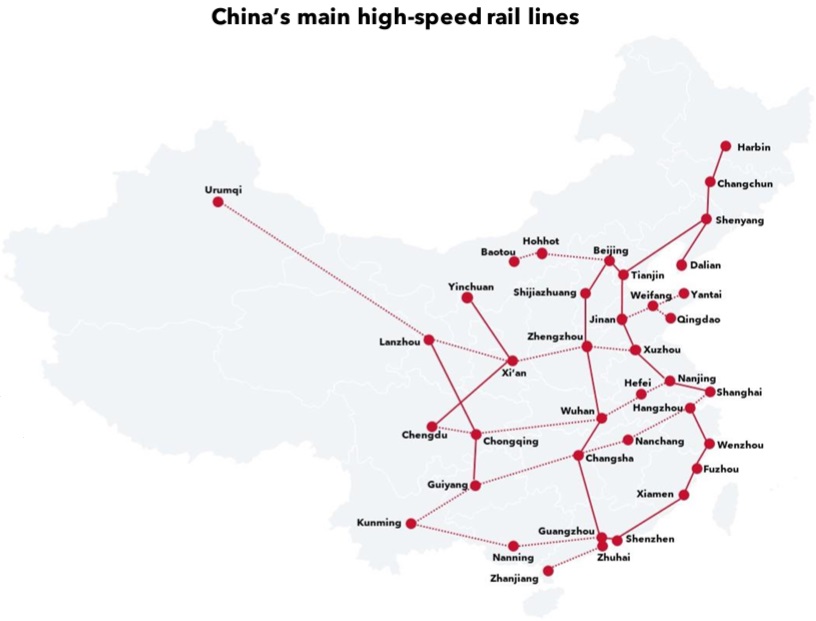
Capable of traveling at speeds of 200-350 km/h (124-217 mph), high-speed trains have greatly reduced domestic journey times: Beijing-Shanghai travel times have been cut from 15 hours to around 4.5 hours.13 Investment in the network continues: 2023 ended with the completion of the Chengdu-Zigong-Yibin line and the opening of the final section of the 560 km Hangzhou-Nanchang route.

An attractive option for some corporate travel
For domestic corporate travel, where time, comfort and convenience are paramount, high-speed rail can be an attractive option. As they’re less likely to be impacted by the weather or air traffic control issues, China’s rail services are noted for their punctuality. Travelers can be confident that they’ll arrive on-time at their destination. Rail services are more convenient, operating from centrally located stations, which may be well-connected via suburban rail services. And once onboard, travelers can enjoy a more comfortable and spacious experience than flying.
While high-speed trains have lowered rail journey times, it’s still quicker to fly, particularly over the vast distances between some of China’s cities. Flying Beijing-Shanghai is still two hours faster than rail, although this excludes the time needed for security checks. Air may be the choice for urgent meetings in remote areas, or when time alone is the priority. China’s main high-speed rail lines Chinese corporate travel policies require each trip’s specific needs to be scrutinized to determine whether air or rail is more appropriate. Consideration is given to distance, time constraints and on-trip employee productivity.
Given its convenience, rail usually proves the better choice for trips of 800-1,200 km (500-750 miles). For longer distances, air tends to prevail by virtue of an aircraft’s faster speed. As the rail network continues to expand and highspeed trains evolve, these boundaries are likely to shift more in favor of rail. And its recognition as a much-needed sustainable travel option will give rail extra impetus in its capture of air travelers.
Shift to high-speed rail travel
A lower cost alternative?
China’s high-speed rail services generally feature three cabins: Second Class, First Class and Business Class. These are equivalent to the economy, premium economy and business/first class products offered by Chinese airlines on domestic flights.
In 2023, China Railway abandoned fixed pricing on its high-speed services in favor of a floating rate, bringing it more in line with airline pricing practices. Ticket prices now depend on time of day, season, number of stops and class of travel. This means a Second Class rail ticket from Beijing to Shanghai can vary in price from CNY404-667 (US$57-94).
With some reports suggesting the cost of high-speed rail travel could be half that of taking a domestic flight, this clearly presents an added reason for travel managers and travelers to consider it.15 But it’s not as simple as this. When comparing the highest full economy airfare for a specific route and time, it’s certainly possible that taking the train could be one-third to a half cheaper than flying. But such is the sophistication of airline inventory and yield management, that it’s equally possible to find airfares lower than rail prices on certain flights, even after including fuel surcharges and airport taxes. Domestic air travel should not be completely disregarded in favor of rail. But the case for rail remains compelling: On average, across top routes, including Shanghai-Beijing, Guangzhou and –Shenzhen, BCD Travel China has found high-speed rail fares to be 40-50% cheaper than flying.
Accessing high-speed rail has become easier for business travelers
Since China Railway introduced e-tickets for all high-speed rail services in 2019, buying tickets has become so much easier. No more queuing at the ticket counter to collect a paper printed ticket. E-ticket introduction has also helped simplify passengers’ boarding experience at the station. Passengers need only scan their passport or ID at ticket-check machines.
Rail inventory is normally loaded in the China Rail ticket booking tool (12306.cn), operated by China Railway Administration Bureau, up to 15 days before departure. BCD Travel China has an API integration in place with this tool, enabling corporate customers to seamlessly book their rail travel, both online and offline. This allows BCD to track booking data in the same way as air and hotel bookings would be managed.

When booking a high-speed rail ticket for the first time, international travelers visiting China must first verify their travel documents and mobile phone number at the railway station. They are then free to purchase e-tickets for their rail travel in the same way as Chinese citizens. Tickets must be paid for using a personal credit card.
Once a ticket is issued, foreign travelers receive an SMS on their designated mobile with the confirmation number. They’ll need to present both their travel documents and e-ticket to board the train, boarding through the manual ticket gates. It’s a good idea for all travelers to print a paper receipt for the transaction, as this is needed for expense reimbursement and VAT refund purposes by legal entities registered in mainland China.
To simplify the inclusion of high-speed rail in travel programs, BCD Travel China has launched Rail+, an end-to-end solution for corporate clients whose employees frequently travel by train. Employees book their tickets through BCD, facilitating corporate central payment, such as an Airplus card. Travelers can still select invoice or personal credit card payment, but whatever the method, BCD also manages receipts and expensing the client’s finance department. Individual travelers no longer need to pay for and expense each rail trip. There’s little chance of receipts being lost. And clients will find it easier to claim their VAT refund.
